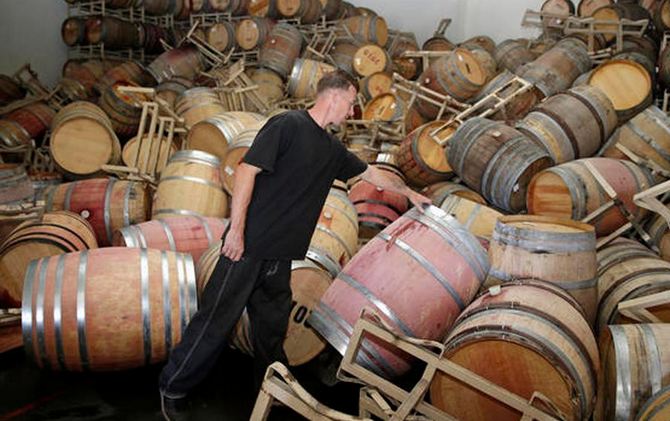
NAPA, California — A powerful earthquake that struck the heart of California’s wine country caught many people sound asleep, sending dressers, mirrors and pictures crashing down around them. Scores were injured as the temblor knocked out power to thousands, caused gas and water lines to rupture and sparked fires.
The magnitude 6.0-quake struck at 3:20 a.m. PDT Sunday near the city of Napa, an oasis of Victorian-era buildings nestled in the vineyard-studded hills of Northern California.
The fires also flared in a mobile home park where four homes were destroyed and two others were damaged, officials said.
By midday Sunday, the fires were out and power was starting to be restored, said Mark Ghilarducci, director of the California Governor’s Office of Emergency Services.
“While it was bad, it wasn’t as bad as it could be and it was very manageable from a regional perspective,” Ghilarducci said.
The quake struck about six miles south of Napa and lasted 10 to 20 seconds depending on proximity to the epicenter, according to the U.S. Geological Survey. It was the largest to shake the San Francisco Bay Area since the magnitude-6.9 Loma Prieta quake struck in 1989, collapsing part of the Bay Bridge roadway and killing more than 60 people, most when an Oakland freeway fell.
It was felt widely throughout the region, with people reporting feeling it more than 200 miles south of Napa and as far east as the Nevada border.
For many, the quake struck at the worst time possible, rousing them in the middle of the night and sending them fumbling in darkness to take cover and find loved ones. A number of the injuries were caused by people stepping on broken glass, falling down or being hit by furniture.
The quake’s timing was also bad for Napa Valley’s famed vineyards, where winemakers were just getting ready to harvest the 2014 crop. The quake broke thousands of bottles of wine and toppled barrels.
Omar Rodriguez, 23, of Napa, was treated for a gash on his forehead in one of the triage tents outside a hospital that handled the victims.
“We woke up to the earthquake and I thought I was dreaming because I fell off my bed, you know, it was all dark, and I just got back up. She noticed it was all bleeding,” he said, referring to his girlfriend.
Officials were still assessing the damage late Sunday in hopes of getting a cost estimate they could submit for possible federal assistance. But the initial assessment found that dozens of homes and buildings in the region were unsafe to occupy, including an historic Napa County courthouse, where a 10-foot wide hole opened a view of the offices inside.
Queen of the Valley Medical Center in Napa reported treating 172 people in the emergency room, although hospital officials could not say how many of them were there for injuries suffered in the quake and how many for more routine injuries and illnesses, hospital CEO Walt Mickens said.
Twelve people were admitted for broken bones and other medical problems directly related to the earthquake, including an adult who remained in critical condition on Sunday night and a 13-year-old boy.
The teen was hit by flying debris from a collapsed fireplace and had to be airlifted to the children’s hospital at the University of California Davis Medical Center for a neurological evaluation. He condition was listed as serious, hospital spokeswoman Phyllis Brown said.
While inspecting the shattered glass at her husband’s storefront office in downtown Napa, Chris Malloy described calling for her two children in the dark as the quake rumbled under the family’s home, tossing heavy pieces of furniture for several feet.
“It was shaking and I was crawling on my hands and knees in the dark, looking for them,” the 45-year-old woman said, wearing flip flops on feet left bloodied from crawling through broken glass.
About 70,000 customers lost power after the quake hit, but Pacific Gas and Electric spokeswoman Nicole Liebelt said early Monday that the number was down to about 150 by 4 a.m.
An earthquake early warning system currently being tested issued a 10-second warning before the quake struck, said Richard Allen, director of the University of California, Berkeley Seismological Laboratory. California is working to implement a statewide system, though Allen said funding has not been secured.
The timing of the quake was bad for business in Napa as well.
Vintner Richard Ward of Saintsbury Winery south of Napa watched Sunday afternoon as workers righted toppled barrels and rescued a 500-pound grape de-stemmer that the quake had thrown to the ground.
“That’s what happens when you’re a mile from the epicenter,” said Ward, who lost 300 to 400 bottles in the winery’s basement.
The grape harvest was supposed to start overnight Monday, but it would now be pushed off a few days, he said. Had the harvest started a day earlier, the quake could have caught the workers among the heavy barrels when it struck, Ward said.
Aftershocks were expected to continue for several weeks, though State Geologist John Parrish said they would decrease in magnitude and it was unlikely that there would be a large follow-up earthquake. Still, he warned people to be careful because buildings that were damaged by the quake were now more susceptible to collapse from aftershocks.
On Sunday night in Southern California, a small, magnitude-3.3 earthquake hit off the region’s coast.
The U.S. Geological Survey says the temblor struck at 7:50 p.m. and was centered about 5 miles southwest of San Pedro and 6 miles southeast of Rancho Palos Verdes. There were no initial reports of damages, police said.
Associated Press writers Juliet Williams in Napa, Lisa Leff in San Francisco, Courtney Bonnell in Phoenix and Daisy Nguyen in Los Angeles contributed to this report.